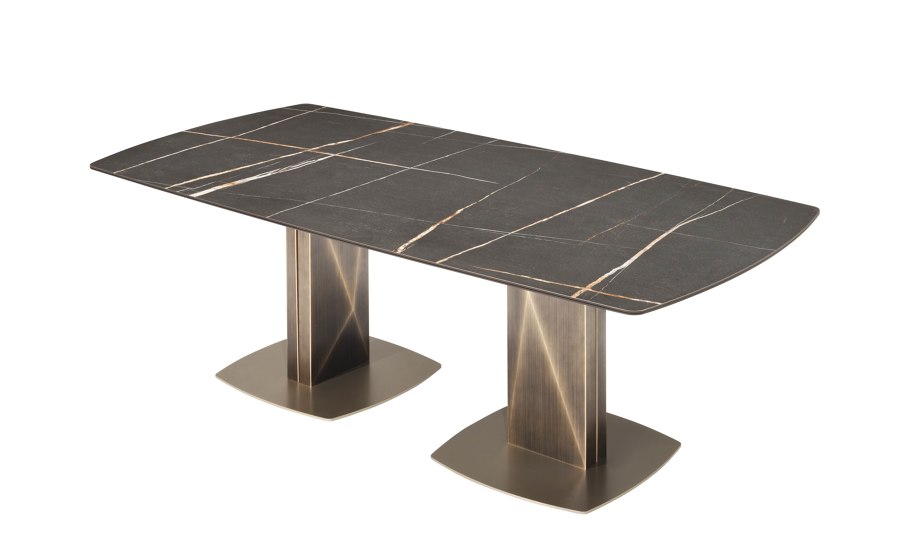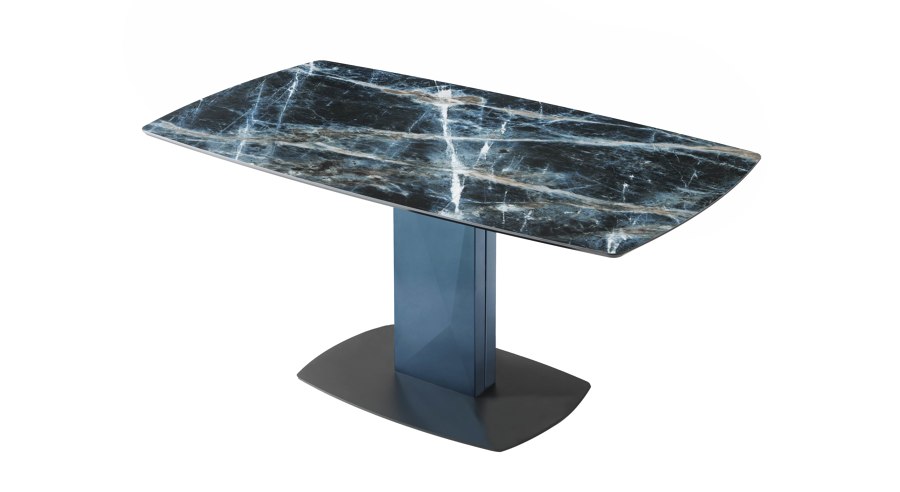Riflessi lays it out on the table
Brand story by Emma Moore
Ortona, Italie
10.10.22
With customisable elements combining to form versatile versions of sculptural distinction, Riflessi's Sabino table adds individual style and function to personal living spaces.
Riflessi’s new Sabino table has a flexible design which allows for different material combinations, sizes and shapes, but in all guises, it makes a striking focal point in a room

Riflessi’s new Sabino table has a flexible design which allows for different material combinations, sizes and shapes, but in all guises, it makes a striking focal point in a room
×Centrepieces are candlesticks and orchids, tumbling fruit mountains and twinkling trays, tiered stands and sculptural vessels. And tables are what they stand on. Or are they? Can the table not be the centrepiece itself? Tables are perhaps the oldest, most primitive form of furniture, with a very important role; to hold the tools of our food, work and play at a height that’s right. But they can also be the sculptural presence that shapes a space.
The round-topped version of Sabino can be extended when more surface space is required, turning the piece into a sculptural lozenge shape

The round-topped version of Sabino can be extended when more surface space is required, turning the piece into a sculptural lozenge shape
×Sign of the times
Basic and essential they may be, but it’s exactly this simplicity of function that feeds the imagination of our top furniture designers. In fact it’s tables that often best reflect the tastes of an age. Isamu Noguchi’s iconic coffee table translates the biomorphic forms of 1950s sculpture into furniture, while the Forme Libre tables from Charlotte Perriand recall the abstract organic shapes of mid century paintings. Carlo Scarpa’s Argo table distilled the mix of old and new geometries that made his architecture so iconic, and the tubular steel and glass tables of the likes of Giotto Stoppino spoke of the 1970s love of chrome combined with volume.
The facetted detailing in the pedestal gives it a distinctive identity, while the many material and shape choices allow Sabino to morph to match many different interior schemes

The facetted detailing in the pedestal gives it a distinctive identity, while the many material and shape choices allow Sabino to morph to match many different interior schemes
×Standing out while fitting in
So what statements are the latest tables making and how are they defining our age aesthetically? Italian furniture makers Riflessi have launched their latest design, Sabino, and it has plenty to say. Firstly, Sabino isn’t one table, but many. While in the past iconic tables perhaps started with one definitive model that has since been adapted to different sizes, materials and finishes, choice leads Sabino’s design, which can come with one pedestal or two, fixed or extendable, round, lozenge-shaped or more sharply angled at the corners. Customisation is in Riflessi’s DNA, influenced in part by founder Luigi Fammiano’s hometown, the tailoring capital Naples, but is increasingly an essential offering of furniture makers today.
'Sabino is designed virtually for any home but at the same time it is original and quite unusual'
'It is at the same time very versatile – because it can easily adapt to every home need with different shapes/dimensions and one or two bases – and eye-catching: it is designed virtually for any home but at the same time it is original and quite unusual,' says Fammiano, explaining the peculiarities that make it universal but distinct. 'It is a piece that focuses all the attention on itself inside a living room.'
For larger table tops, a second cubic pedestal can be added for further stability, the second one positioned perpendicular to the first

For larger table tops, a second cubic pedestal can be added for further stability, the second one positioned perpendicular to the first
×Sculptural detail
The cubic base provides much of the originality, and like many talking points when it comes to furniture design, it demonstrates a new application of an old technique – something Riflessi already explored for the brand’s Cubric Sideboard doors. 'Straight lines are “subverted”; an effect obtained with a particular artisanal technique which simulates a three-dimensional effect. The idea was to give an unexpected, tridimensional appearance to an element like the base of the table, that is usually considered just functional,' explains Fammiano, whose Abruzzo-based brand proudly bears the Made in Italy stamp, taking advantage of the rich local material resources old and new, alongside the much-lauded skills of the nation’s artisans.
With a circular top, Sabino makes a statement hall table. By contrasting the materials of the base, pedestal and top it has a totemic, sculptural presence

With a circular top, Sabino makes a statement hall table. By contrasting the materials of the base, pedestal and top it has a totemic, sculptural presence
×Material mix-up
Also a defining factor is the way materials, colours and textures can be mixed throughout the piece. The top might be a ceramic decorated with an opulent marble-like finish, while the cubic plinth might feature a hand-brushed brass, titanium or cobalt finish, or be coated with the mirrored stainless steel finishes Reflect Blue, Reflect Rose Gold and Reflect Black. The foot equally can be chosen from a variety of metal finishes to contrast the plinth. 'The combination between different materials and different colours is the heart of contemporary taste in my opinion, and this is testified by the growing request of customisations coming from both our private clients alongside designers and architects.'
Sabino epitomises our present love for modular and mixed materials combined in a sculptural, totemic manner, and needs no floral adornments or cascading grapes to hold its own as a thoroughly modern centrepiece to a hallway, living room or dining space.
© Architonic
Head to the Architonic Magazine for more insights on the latest products, trends and practices in architecture and design.


















